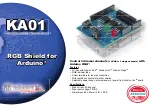
8.0 ET PROGRAMMING
Rain Master Eagle User Manual
- 82 -
8.1.1 ET Scheduling Overview
Your Rain Master Eagle controller has been designed to offer several different ET options to
facilitate immediate water savings, regardless of the configuration chosen. Additionally, the Rain
Master Eagle incorporates a “one-button” (ET key) approach in order to best serve your needs
In order to take advantage of the ET water savings capability built within your Rain Master Eagle
controller you must perform the following steps:
Table 7 - ET Data Entry
Operation
Description
Reference Section
Step 1 - Obtain the Historical
ET Data
Obtaining and entering the
twelve monthly ET values.
8.2
Step 2 - Generate a Reference
Program
Enter the start times,
stations, and water days.
8.3
Step 3 - Establish the ET
Reference Value
Enter the reference
ET data value.
8.4
Step 4 - Enable ET Operation
Mode
Set Programs to ET mode or
conventional program mode.
8.5
Step 5 - Select the ET data
source
Select historical, weather
station, manually entered,
or the inernet.
8.6
8.2 OBTAINING THE HISTORICAL ET DATA
Historical Evapotranspiration is accumulated ET data (typically accumulated 5 years or longer)
compiled on a monthly basis for a specific location. This data is often times collected and
maintained by various state and local agencies. In order to utilize the ET Scheduling features of
the Rain Master Eagle, historical ET must be entered into the controller.
Rain Master Irrigation Systems has assimilated Evapotranspiration data for the entire United States
The weather parameters used to derive historic ET has been obtained from nationally recognized
weather stations and observation systems. The historic ET data was averaged over a thirty (30) year
period. The data is organized by United States postal zip codes and is available at the Rain Master
Irrigation Systems Website www.rainmaster.com.
In order to use historical ET data as your source you must enter the historical data into the Rain
Master Eagle for each month of the year based upon your climate.
Once you have obtained your local specific data, refer to section 7.4 ENTERING HISTORICAL
ET MONTHLY VALUES for the procedures necessary to enter the data into your Rain Master
Eagle controller.
Utilization of historical data allows water savings to be achieved in an immediate fashion. Savings
are realized because your Rain Master Eagle has been designed to re-compute station runtimes
based upon climactic trends as defined by monthly historical ET information. The controller
performs daily station runtime computations based upon the weather conditions, in turn, water
savings are realized since the controller automatically adjusts based upon need.
Although historical data is very useful, using historical data by itself means that the controller will
not be able to adjust to real-time conditions such as an overcast day or an exceptionally hot day,
since historical data is averaged data.
Summary of Contents for RME EAGLE EG Series
Page 1: ......
Page 2: ......
Page 6: ...Notes Rain Master Eagle User Manual iv Notes...
Page 132: ......
















































